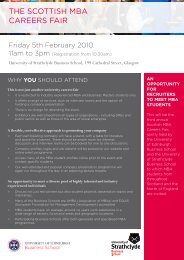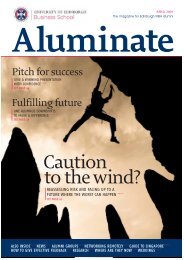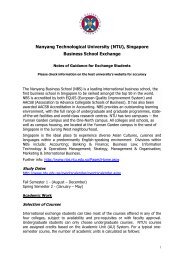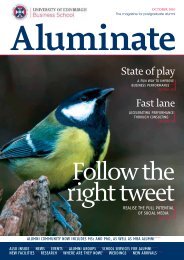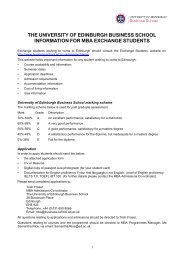killed Saab Automobile? - Business School - University of Edinburgh
killed Saab Automobile? - Business School - University of Edinburgh
killed Saab Automobile? - Business School - University of Edinburgh
You also want an ePaper? Increase the reach of your titles
YUMPU automatically turns print PDFs into web optimized ePapers that Google loves.
Merger with Scania<br />
In 1968 <strong>Saab</strong> announced their intention to merge with Scania-Vabis, a Swedish producer <strong>of</strong> trucks and<br />
diesel engines. The merger took place in 1969. In addition to production facilities in Sweden itself,<br />
Scania operated plants in Brazil and the Netherlands. Production <strong>of</strong> <strong>Saab</strong> cars expanded into Finland in<br />
1968 with a joint venture with Valmet, a state-owned Finnish company.<br />
By the 1970s, the company was a fully-fledged technology conglomerate with a product division<br />
structure, comprising four main divisions: Aerospace, Scania Trucks, Cars and Nordarmatur (who<br />
produced valves and pipes).<br />
Like many companies, <strong>Saab</strong> was hit by the recession that followed the oil shock <strong>of</strong> the early 1970s, with<br />
a slight fall in car production. Some countries had already seen rationalization <strong>of</strong> their motor industries.<br />
In the late 1960s the UK, for example, had seen the creation <strong>of</strong> the British Leyland Motor Corporation, a<br />
disastrous amalgamation <strong>of</strong> several smaller auto producers and a truck maker that had to be rescued<br />
by the UK Government within a few years <strong>of</strong> its formation iii .<br />
Sweden faced similar pressures towards scale and rationalisation and in 1977, the Boards <strong>of</strong> Volvo and<br />
<strong>Saab</strong>-Scania proposed merger <strong>of</strong> the two companies, in large part because new model development<br />
was prohibitively expensive for small auto producers – hence the very long model cycles <strong>of</strong> <strong>Saab</strong> and<br />
Volvo cars. However, these merger proposals came to nothing for reasons that included differences in<br />
design philosophy, fears on the part <strong>of</strong> <strong>Saab</strong> that its identity would be lost given Volvo’s greater size<br />
and concern from both that the other would cannibalize their existing share <strong>of</strong> the trucks market iv .<br />
<strong>Saab</strong> Cars in the 1970s and 80s<br />
<strong>Saab</strong>’s car division therefore took a different route to controlling development costs, entering into<br />
agreements with Italy’s Lancia which resulted in the co-development <strong>of</strong> the platform on which the <strong>Saab</strong><br />
9000 (launched in 1984), the Fiat Croma, the Alfa Romeo 164 and the Lancia Thema were<br />
subsequently based. The 9000 symbolised <strong>Saab</strong>’s serious arrival into the European luxury segment.<br />
Tellingly, this was only <strong>Saab</strong>’s third all-new model launch in what was by then nearly 40 years <strong>of</strong> car<br />
manufacturing.<br />
1977 saw a major innovation with the introduction <strong>of</strong> a turbo-charged version <strong>of</strong> the <strong>Saab</strong> 99, the first<br />
turbo-charged production car in the world. Shortly after this, the <strong>Saab</strong> 900, a major evolution <strong>of</strong> the 99<br />
was launched. Turbo-charging was one <strong>of</strong> <strong>Saab</strong>’s signature attributes during the 1980s and reinforced<br />
the <strong>Saab</strong> brand as innovative and technologically advanced whilst adding ‘power’ and ‘performance’ to<br />
the mix. This complemented the marque’s earlier rallying success. In the world <strong>of</strong> automotive branding,<br />
technological sophistication is a way <strong>of</strong> saying ‘My car is better than yours’ v (or possibly ‘I’m more<br />
sophisticated than you are’) and turbo-charging undoubtedly helped perform this function.<br />
In Germany, Audi was pursuing a similar branding strategy. In the 1980s Audi successfully repositioned<br />
itself from being a worthy but dull brand, the kind <strong>of</strong> car that bank mangers drive, to the kind <strong>of</strong> car that<br />
young, aspiring (and relatively wealthy) buyers might want, using technological innovation as the<br />
means. In its UK advertising the slogan ‘Vorsprung durch Technik’ – ‘progress through technology –<br />
epitomized this vi . Audi used innovations such as sleek aerodynamics (represented by a TV commercial<br />
showing an Audi 100 towing a series <strong>of</strong> parachutes) and four wheel drive (an attractive woman chasing<br />
her hang-gliding man up a mountain in an Audi Quattro to tell him his mother is calling him on his car<br />
phone) to drive home this message. In the space <strong>of</strong> a few years the average age <strong>of</strong> an Audi driver in<br />
6





